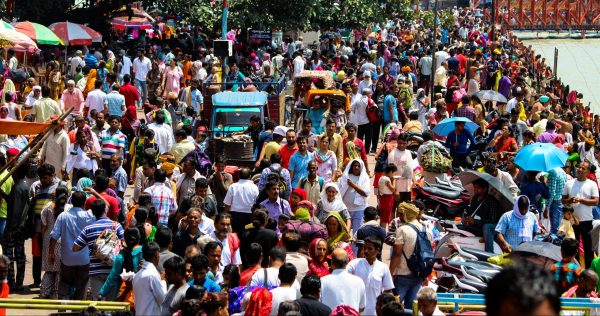
Understanding Rajasthan’s Urban Unemployment Challenge
27 September 2022
The pandemic induced slowdown gripped the country and many states faced an unprecedented migrant crisis. Inevitably, the unemployment rate shot up in almost all the Indian states. While a scheme like the Mahatma Gandhi National Rural Employment Guarantee Scheme (MGNREGS) helped provide employment to rural India, the absence of a similar scheme in most parts of urban India, led to no social protection against skyrocketing unemployment.
As the chart below displays, urban unemployment reached its peak during the first wave of the pandemic in 2020, and rose again during the second wave in 2021. Throughout this period, Rajasthan and Haryana continued to witness rising unemployment, while other states like Jharkhand, Bihar and Telangana gradually moved towards recovery.
Since August 2021, only Rajasthan, Bihar, Jharkhand and Haryana have breached the 20% mark for urban unemployment; other states have successfully brought back their unemployment rates closer to pre-pandemic levels. In states with high urban unemployment, Rajasthan stands among the top three states with a rate of 27.7% as of June 2022.
Urban Employment in India: CMIE Monthly Data (May 2018-June 2022)

As of July 2022, six states in India — Kerala, Jharkhand, Rajasthan, Odisha, Himachal Pradesh and Madhya Pradesh — had announced or implemented some form of urban employment guarantee programme. While Kerala’s Ayyankali Urban Employment Guarantee Scheme (AUEGS) has been functional since 2011, Madhya Pradesh and Odisha implemented their schemes in 2019 and 2020, respectively. Coincidentally, these states are also the ones with the lowest urban unemployment rates currently. Rajasthan is the latest state to announce a similar scheme.
The Government of Rajasthan’s Indira Gandhi Urban Employment Guarantee Scheme, which is modelled on its national rural counterpart, MGNREGS, is a welcome move. It is in line with the recommendations and suggestions provided in the report commissioned by EAC-PM and aims to fill a serious employment gap in the urban sphere.
Possible challenges to Rajasthan’s Urban Employment Guarantee Scheme
While the scheme is a necessary response to Rajasthan’s urban unemployment problem, it comes with certain challenges and limitations. These challenges correspond to the type of work, the payment process and the registration process.
The scheme prioritises labour-intensive work to ensure the employment of a large number of people. However, Rajasthan’s high number of unemployed graduates might not benefit from this as they might rather choose to engage in skill-based work; the scheme does provide for ‘technical work’ where skilled workers shall be employed, albeit in a smaller number. Through the latter, the scheme hints at creating necessary public infrastructure, which can increase the requirement of workers in the public sector, thereby increasing employment. The same is also recommended in the State of Working India report (2021) by Azim Premji University.
Additionally, the scheme draws from MGNREGS to create an MIS portal for monitoring, evaluation and transparency. While MIS portals have become almost essential for monitoring and evaluation of government schemes in the past few years, they are prone to many issues concerning payments and budget allocations. For instance, the MIS website for MGNREGS considers “wages paid” once the Fund Transfer Order (FTO) [1] is signed by the second signatory, despite there being a significant gap between the signature and the actual transaction. Thus, it remains to be seen whether the MIS portal for the scheme can lead to more transparency, and better monitoring and evaluation.
An important aspect of the scheme is the mandatory use of the Jan Aadhaar Card for availing a job card. The government of Rajasthan has made Jan Aadhaar mandatory for many such state-level schemes, often leading to the exclusion of many people, including people from outside the state who are not eligible for one. The penetration of the card is also contentious — while the official website for Jan Aadhaar claims that 1,92,71,753 families have registered for the card, an RTI response from the Department of Information Technology and Communication put the number at 19,15,005, almost a tenth of the public claim. Given this inconsistency and huge variability between government figures, if indeed Jan Aadhar penetration is not deep in Rajasthan, it poses trouble for migrant workers, and marginalised people and especially those who do not possess any form of identity.
The Rajasthan Jan-Aadhaar Authority Act, 2020 reinforces this problem further as only “residents” of the state [2] — people who have resided in a local area of Rajasthan for the past six months or more — are eligible to register for a Jan Aadhaar Card. Thus, the mandatory possession of a Jan Aadhar Card might end up being counterproductive.

Conclusion
The Indira Gandhi Urban Employment Guarantee Scheme comes after multiple recommendations to create a demand-based solution like MGNREGS to the problem of urban unemployment. Launched in the light of COVID-19, the scheme remains relevant as the state leads in terms of urban unemployment rate. Rajasthan shall face multiple challenges while implementing the scheme — creating a functioning and transparent MIS, providing employment to a large number of unemployed graduates, and most importantly, ensuring that the mandatory usage of the Jan Aadhaar card does not lead to exclusion of people.
Kuber Bathla was a Research Intern at the Accountability Initiative.
Also Read: Decline in Unemployment Rate in 2020-21: A Reason to Rejoice or Worry?
NOTES
[1] Under the electronic Fund Management System (e-FMS), funds are held at one account at the state level, which is linked to the implementing levels (Gram Panchayat/Block). The implementing agencies then generate FTOs for transferring wages directly into the workers’ accounts after due verification of their work.
[2] The 2020 Act defines the term as: “resident”, with all its grammatical variations, means a resident who has resided in a local area of Rajasthan for the past six months or more or a person who intends to reside in that area for the next six months or more.”





